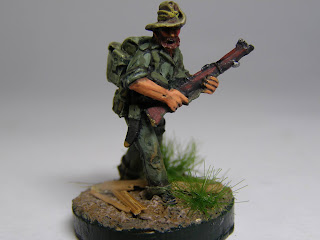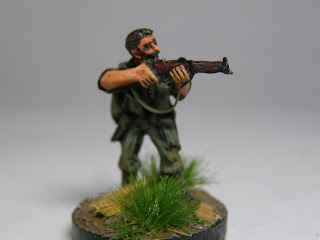The random nature of my posts continues! This time we have Chindits from the WW2 Burma campaign.
Since preparing my WW1 collection and getting it ready for playing with Chain of Command, I found myself also getting interested in the idea of a Far East campaign for WW2. I must confess that one area of WW2 that I know least about is the Burma campaign, having focussed so much on Normandy and North Africa. I feel I have neglected knowing the detail of battles in other theatres.
Having once spent 7 months in the jungles of Belize (though a pale shadow of the difficulties of Burma in the monsoons), I think I have always been put off by the thought of creating jungle terrain. Though like so much else, if one puts ones mind to it there are ways and means of representing things without having to go to excessive lengths.
What really sparked this purchase was reading the memoirs written by the famous author of the 'Flashman' and McAuslan and many other excellent works. George MacDonald Fraser's book 'Quartered Safe Out Here' is about his experiences as a rifleman in the Kings Own Border Regiment and is probably one of the best memoir books I have ever read. This inspiration prompted me to want to learn more and so I found myself looking at wargaming figures.
I painted and finished these in about a week. I found these to be very different to my usual fare of brightly coloured coats and lace and it was interesting to research the colours used and look at photos in books and online.
The figure below has an accidental tattoo on his forearm. A stray bristle had applied paint to his forearm and it actually made for a realistic tattoo, which I didn't spot until I enlarged this photo! Such things being popular among servicemen even then, I shall probably keep the tattoo on him. I might try to improve it further.
The Warlord Games Chindit Section comes in a box of 10 metal figures. They were quite well cast with not too much flash. I was disappointed to find that one soldier's M1 carbine was without a barrel and then I heard it rattling in the box. This took some gluing back! It involved 'Greenstuff' modelling putty and then trying to disguise the new shape on the M1 fore-end...pics are further down.
I liked the variety of the kit carried, the poses and the demeanour of the troops. It was good to see Kukris and machetes being carried and extra water bottles. Some thought had clearly been put into to these.
Small niggles are that I think the SMLE's are slightly too short and that some heads seem to be a bit narrow (rather like some of the old Redoubt figures). The Bren gunner appears afflicted like this.
There was a near complete absence of slings on the figures. This, it could be argued, was because the men would have taken the slings off to move through the jungle. However, personal experience of carrying small arms through jungle would lead me to believe that slings would stay on. Far easier to hack through jungle with a heavy blade if your rifle is slung. Most of the work is going to be arduous marching, dragging kit and fellow troops across unexpected rivers and up muddy slopes, or even pulling mules as in the Chindits case. I rectified the sling situation with strips of paper with PVA white glue painted on to strengthen them, followed by painting in webbing colours.
The figure below appears to have his sling cast on and pulled short and tight over the magazine and under his hands, which I thought was ok, so I didn't add one on here. Making slings was fiddly anyway!
Below we see one figure with an M1 Carbine. This is the one that arrived broken. To attempt to disguise the bulge of modelling putty, I made a sling which had clearly looped itself over the fore-end. with this feasible excuse the eye seemed to forgive the awkwardness. It was certainly better than a missing barrel at any rate.
Once I had made the sling for this figure, I decided to do it for the rest of the section too.
One of my overwhelming memories of living and patrolling in jungle was the mud. Rotting vegetation and mud, and I imagine that Burma would have it far worse than Central America. So I kept a large proportion of mud effect on the bases and dirtied boots, knees etc for the campaign look. The bamboo bits are from the washing basket which after 30 years is starting to disintegrate. At long last I have a use for it. I am now in no hurry to replace the basket as it is now really proving it's worth!
I rather liked the head and hat and general pose of this figure (above and below). He looks right. Under-fed, hair short/shaved, even if he does not have a Chindit style beard. Some of these figures are very well sculpted. I had reservations when I first saw them, probably the negative feeling from the broken rifle did not help, but they grew on me as I applied paint.
I probably will continue with building these up and adding Japanese to make a platoon with supports for each side. I saw some magnificent AB Chindits in 20mm online yesterday that had me wishing for those, but there is no corresponding Japanese range, sadly.

I think these troops look like the hardened campaigners that they are meant to represent and I do quite like them. As I painted them I kept thinking of what I have read about the troops who served in the hellish terrain, heat and climate of Burma and fought and finally defeated such a bitterly dangerous enemy. My respect for them has continued to grow.
More to follow in due course. I have kept my A4 step by step painting guide of paints used so I can pick up where I left off with no difficulty. In the meantime I shall no doubt meander down some other historical path!


















































































